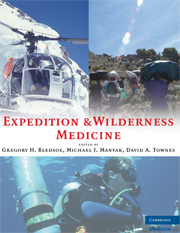Book contents
- Frontmatter
- Contents
- Contributors
- Foreword
- Preface
- Acknowledgments
- PART I EXPEDITION PLANNING
- 1 The Expedition Physician
- 2 Assessing Expedition Medical Needs
- 3 Expedition Medical Kit
- 4 Immunizations
- 5 Legal Considerations during Expedition Planning
- 6 Travel Safety
- 7 Nutritional Support for Expeditions
- 8 Water Treatment
- 9 Special Considerations
- 10 Communications Planning for the Expedition Medical Officer
- 11 Minimizing Risk on an Expedition
- 12 The Expedition Returns
- PART II EXPEDITIONS IN UNIQUE ENVIRONMENTS
- PART III ILLNESS AND INJURIES ON EXPEDITIONS
- APPENDIX The Expedition Medical Kit
- Index
6 - Travel Safety
from PART I - EXPEDITION PLANNING
Published online by Cambridge University Press: 05 March 2013
- Frontmatter
- Contents
- Contributors
- Foreword
- Preface
- Acknowledgments
- PART I EXPEDITION PLANNING
- 1 The Expedition Physician
- 2 Assessing Expedition Medical Needs
- 3 Expedition Medical Kit
- 4 Immunizations
- 5 Legal Considerations during Expedition Planning
- 6 Travel Safety
- 7 Nutritional Support for Expeditions
- 8 Water Treatment
- 9 Special Considerations
- 10 Communications Planning for the Expedition Medical Officer
- 11 Minimizing Risk on an Expedition
- 12 The Expedition Returns
- PART II EXPEDITIONS IN UNIQUE ENVIRONMENTS
- PART III ILLNESS AND INJURIES ON EXPEDITIONS
- APPENDIX The Expedition Medical Kit
- Index
Summary
Many travelers are seeking exotic, remote, and potentially dangerous venues. These may include extremes of altitude, temperature, isolation, and potential political instability.
Most expeditions are planned by professionals with experience in handling local climates, cultures, and conditions. Whether you are traveling with a scientific expedition or a remote tourist adventure, most serious expeditions take planning down to the last detail. Despite preparations, many expeditions are subject to severe conditions and both natural and man-made calamities. It is essential, therefore, that regardless of the degree of leadership or external preparation, the adventure traveler must take ownership of his or her own safety.
The objectives of this chapter are to provide practical insights pertaining to travel safety as it relates to man-made hazards, such as transportation safety, theft, assault, and imprisonment, with a particular emphasis on avoiding problems while traveling. The chapter is intended to provide useful suggestions that may, to some, seem very basic and obvious but that, for many reasons, are important to ensure safe and unobstructed travel, especially to remote or unfamiliar destinations. For additional information about conflict areas or regions of political instability, see Chapter 14.
NEW TRENDS IN TRAVEL: GROWTH IN THE NONTRADITIONAL TRAVEL INDUSTRY
The rapidly expanding market of adventure and remote travel, as well as the massive international tourist industry, has increased travelers' exposure to all sorts of travel-related hazards, both natural and man-made. Travelers now have access to a greater number of adventure tours, remote explorations, and exotic cultures.
- Type
- Chapter
- Information
- Expedition and Wilderness Medicine , pp. 76 - 82Publisher: Cambridge University PressPrint publication year: 2008



